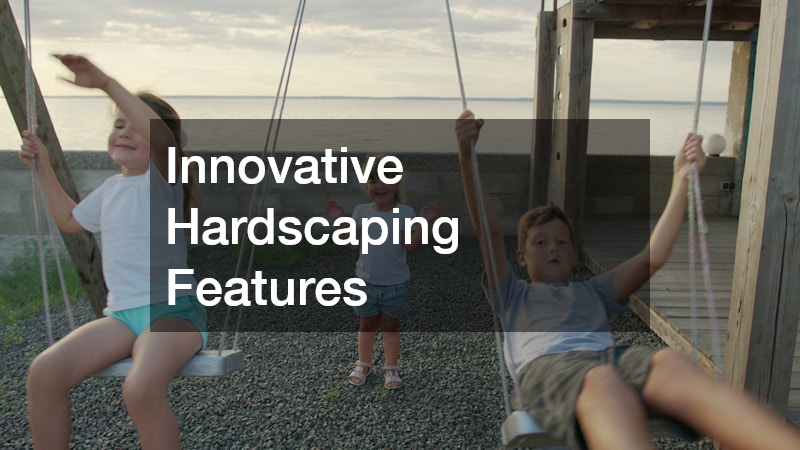Hardscaping plays a crucial role in landscape design by introducing structural elements that enhance both aesthetics and functionality. In this article, we’ll explore the significance of hardscaping in creating functional outdoor spaces. The integration of hardscape design with natural elements is not just about visual appeal but also serves practical purposes.
What is Hardscaping and Why is it Important?
Defining Hardscaping
Hardscaping refers to the non-living elements of landscaping, such as patios, walkways, and retaining walls. These structures form the backbone of outdoor design, providing much-needed support and definition to space.
When properly planned and executed, hardscaping can transform an ordinary yard into a luxurious outdoor haven.
The choice of materials and structure in hardscaping is as critical as selecting the plants for a garden. Whether it’s the sleek lines of concrete or the rustic charm of natural stones, each element plays a part in shaping the environment. The key is to blend creativity with practicality for a harmonious landscape design.
Hardscaping elements are not just visually engaging but also functional. They offer stability to the landscape and define areas for specific purposes, which can range from pathways to seating regions. This structured approach to landscaping uses principles of design to achieve an aesthetically pleasing and practically usable space.
The Benefits of Hardscaping
Hardscaping is crucial for adding functionality, sustainability, and value to outdoor spaces. For instance, a well-planned patio area can serve as a dedicated space for entertainment and relaxation, extending the living area of a home outdoors. Moreover, integrating hardscape features can significantly enhance a property’s market value.
Another key benefit of hardscaping is its contribution to environmental sustainability. Features like permeability and stormwater management can be incorporated to reduce runoff and conserve water. The use of sustainable materials further enhances the eco-friendly nature of a landscape.
Hardscaping also provides durability against weather extremes. Unlike plants, which may require considerable upkeep, hardscape structures endure the seasons with minimal maintenance. This low-maintenance aspect makes hardscaping an attractive choice for homeowners seeking beautiful yet manageable outdoor spaces.
How Hardscaping Enhances Outdoor Functionality
Creating Usable Spaces
By using hardscaping, homeowners can create areas like outdoor kitchens, seating, and entertainment zones. These spaces not only expand the home’s living area but also provide unique venues for gatherings and relaxation. Hardscaped features define specific functions and can turn any backyard into a multi-use environment.
A meticulously crafted patio or deck, for example, serves as an ideal relaxation or dining spot, replete with the ambiance that natural settings offer. Hardscaped zones are designed to accommodate comfort and usability, integrating furniture and decor that match the surroundings. This practical approach encourages more time spent outdoors, enhancing the lifestyle of the occupants.
Moreover, well-designed hardscape areas facilitate ease of movement, allowing individuals to seamlessly navigate through outdoor spaces. Steps, pathways, and driveways provide structured access across gardens and fields. The concept of designating zones encourages an organized and purposeful backyard layout.
Weather Resistance and Low Maintenance
Hardscaped areas require less maintenance and are more durable in various weather conditions compared to plant-based landscapes. Rain, snow, and harsh sunlight have less impact on resilient materials like stone or concrete. This durability ensures that hardscape elements maintain their look and functionality over time.
Choosing weather-resistant materials is crucial for reducing the need for frequent repairs or replacements. Features such as retaining walls not only combat erosion but also offer a long-lasting solution for grading issues in the landscape. With routine care as simple as occasional cleaning, hardscaping provides a low-maintenance solution for busy homeowners.
Weather-resistant hardscaping also means that spaces can be designed for year-round enjoyment. By selecting materials that withstand seasonal changes, outdoor living areas remain accessible and inviting regardless of climate conditions. This all-season capability is a key reason why hardscaped properties are favored by those seeking functional outdoor spaces.
Popular Hardscaping Materials and Features
Common Materials Used in Hardscaping
Explore the variety of materials such as stones, pavers, bricks, and concrete used in hardscaping. Each material offers distinct benefits in terms of look, durability, and functionality. The selection typically depends on the desired aesthetic and structural requirements of the project.
Natural stone, known for its elegance and resilience, is often chosen for features like retaining walls and pathways. Pavers offer versatility and come in a multitude of colors and designs, making them a popular choice for patios and driveways. Bricks provide a classic look and enduring strength, while concrete is favored for its modern appeal and adaptability.
Innovative Hardscaping Features
Features like water gardens, stone fire pits, and vertical walls add uniqueness and functionality. Such innovations not only elevate the aesthetic appeal but also enhance the utility of outdoor spaces. Water gardens can bring tranquility, while fire pits create cozy gathering spots for evening relaxation.
Vertical walls add dimension and intrigue, making smaller spaces appear grander and more defined. These structures effectively utilize vertical spaces, offering room for decorative elements or privacy solutions. Incorporating such creative features reflects a personalized touch, aligning the landscape with the homeowner’s vision.
For those looking to enhance their property, investing in a quality hardscape design promises a blend of function and form that can be enjoyed for generations. The strategic addition of stones, bricks, and other elements ensures that landscapes remain as serviceable as they are beautiful. Embracing hardscaping as an integral part of outdoor development unlocks endless possibilities for outdoor living.




